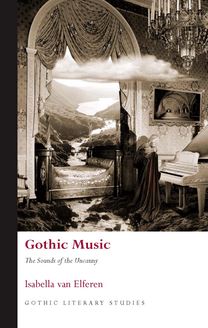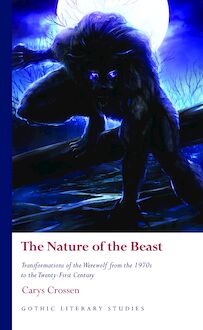-
 Univers
Univers
-
 Ebooks
Ebooks
-
 Livres audio
Livres audio
-
 Presse
Presse
-
 Podcasts
Podcasts
-
 BD
BD
-
 Documents
Documents
-
- Cours
- Révisions
- Ressources pédagogiques
- Sciences de l’éducation
- Manuels scolaires
- Langues
- Travaux de classe
- Annales de BEP
- Etudes supérieures
- Maternelle et primaire
- Fiches de lecture
- Orientation scolaire
- Méthodologie
- Corrigés de devoir
- Annales d’examens et concours
- Annales du bac
- Annales du brevet
- Rapports de stage
La lecture à portée de main
Découvre YouScribe en t'inscrivant gratuitement
Je m'inscrisDécouvre YouScribe en t'inscrivant gratuitement
Je m'inscrisEn savoir plus
En savoir plus

Description
This book explores the history of the paranormal romance genre; from its origins in the revisionist horror fiction of the 1970s, via its emergence as a minor sub-genre of romantic fiction in the early 1990s, to its contemporary expansion in recent years into an often-controversial genre of mainstream fiction. Tracing the genre from its roots in older Gothic fiction written by and for women, it explores the interconnected histories of Gothic and romantic fiction, from Ann Radcliffe and Jane Austen in the eighteenth century to Buffy, Twilight, True Blood and The Vampire Diaries in the present day. In doing so, it investigates the extent to which the post-Twilight paranormal romance really does represent a break from older traditions of Gothic fiction - and just what it is about the genre that has made it so extraordinarily divisive, captivating millions of readers whilst simultaneously infuriating and repelling so many others.
Sujets
Informations
| Publié par | University of Wales Press |
| Date de parution | 15 mai 2014 |
| Nombre de lectures | 0 |
| EAN13 | 9781783160655 |
| Langue | English |
| Poids de l'ouvrage | 3 Mo |
Informations légales : prix de location à la page 0,4400€. Cette information est donnée uniquement à titre indicatif conformément à la législation en vigueur.
Extrait
THE TWILIGHT OF THE GOTHIC?SERIES PREFACE
Gothic Literary Studies is dedicated to publishing groundbreaking
scholarship on Gothic in literature and film. The Gothic, which has
been subjected to a variety of critical and theoretical approaches,
is a form which plays an important role in our understanding of
literary, intellectual and cultural histories. The series seeks to
promote challenging and innovative approaches to Gothic which
question any aspect of the Gothic tradition or perceived critical
orthodoxy. Volumes in the series explore how issues such as gender,
religion, nation and sexuality have shaped our view of the Gothic
tradition. Both academically rigorous and informed by the latest
developments in critical theory, the series provides an important
focus for scholarly developments in Gothic studies, literary studies,
cultural studies and critical theory. The series will be of interest to
students of all levels and to scholars and teachers of the Gothic and
literary and cultural histories.
SERIES EDITORS
Andrew Smith, University of Glamorgan, UK
Benjamin F. Fisher, University of Mississippi, USA
EDITORIAL BOARD
Kent Ljungquist, Worcester Polytechnic Institute Massachusetts
Richard Fusco, St Joseph’s University, Philadelphia
David Punter, University of Bristol
Chris Baldick, University of London
Angela Wright, University of Sheffield
Jerrold E. Hogle, University of ArizonaThe Twilight of the Gothic?
Vampire Fiction and the Rise of
the Paranormal Romance
Joseph Crawford
UNIVERSITY OF WALES PRESS
CARDIFF
2014© Joseph Crawford, 2014
All rights reserved. No part of this book may be reproduced in any material
form (including photocopying or storing it in any medium by electronic
means and whether or not transiently or incidentally to some other use of
this publication) without the written permission of the copyright owner.
Applications for the copyright owner’s written permission to reproduce
any part of this publication should be addressed to the University of Wales
Press, 10 Columbus Walk, Brigantine Place, Cardiff CF10 4UP.
www.uwp.co.uk
British Library CIP Data
A catalogue record for this book is available from the British Library.
ISBN 978-1-78316-064-8
e-ISBN 978-1-78316-065-5
The right of Joseph Crawford to be identified as author of this work has
been asserted by him in accordance with sections 77 and 79 of the
Copyright, Designs and Patents Act 1988.
Typeset in Wales by Eira Fenn Gaunt, Cardiff
Printed by CPI Antony Rowe, Chippenham, WiltshireCONTENTS
Acknowledgements vii
Introduction 1
1 The First 800 Years 11
2 Romancing the Paranormal 60
3 Sleeping with the Enemy 107
4 The New Millennium 138
5 The Twilight Controversy 181
6 Mutations 237
Epilogue Signs and Portents: Red Riding Hood, Snow White
and the Huntsman and Fifty Shades of Grey 271
Notes 279
Bibliography 313
Index 327ACKNOWLEDGEMENTS
I began this book in Cambridge; I finished it in Exeter. I wish to
extend my sincere thanks to University of Cambridge for the
research fellowship which allowed me to begin this book, to the
University of Exeter for the lectureship which allowed me to finish
it, and to my colleagues at both. I also wish to thank my wife, Filipa,
who persuaded me to keep watching True Blood, and allowed me
to persuade her to keep watching The Vampire Diaries in return.
Virtually every idea in this book originated during our interminable
conversations about Buffy the Vampire Slayer, back when we lived
in London and were too short of money to go out. She should
probably take credit for most of the best ones.
I wish to thank Mary Janice Davidson, Maggie Shayne and
Roxanne Longstreet for their willingness to be interviewed for this
project, at times when I’m sure they would all rather have been at
work on their latest novels; special thanks to Roxanne for taking
time out from her signing tour in order to meet with me directly.
Further thanks are due to my family – Richard, Elaine, Rosa, Oliver
and Sophia – for their unstinting support during the writing of this
book, and for the good-humoured tolerance with which they treated
me during those months when all I ever wanted to talk about was
vampire sex books for teenage girls. I also wish to especially thank
Sarah Lewis at the University of Wales Press for championing this
project from its earliest stages: without her support, it would probably
never have been written!
This book is dedicated, with great affection, to the graduate
students of the King’s College London genre fiction reading group:
Sarah Crofton, Maria Damkjaer, Jordan Kistler, Matt Sangster,
Mary Shannon, Will Tattersdill and all the rest. You may not know
it, but this is all your fault. Acknowledgements
We are grateful for permission to reproduce the following material
in this volume:
Introduction, copyright © 2009 by Annette Curtis Klause; and ‘The
Silver Kiss’ from the The Silver Kiss by Annette Curtis Klause,
copyright © 1990 by Annette Curtis Klause. Used by permission of
Delacorte Press, an imprint of Random House Children’s Books,
a division of Random House LLC. All rights reserved.
There are instances where we have been unable to trace or contact
the copyright holder. If notified the publisher will be pleased to
rectify any errors or omissions at the earliest opportunity.
viiiK
Introduction
Not very many years ago, I used to attend a graduate reading group
at King’s College London, devoted to the study of popular genre
fiction. At each session, a different form or genre would be discussed:
detective fiction, or science fiction, or online fan fiction, or comic
books. The students who attended were well read, but they were
also broad-minded, swift to recognize that popular fictional genres
could possess cultural and historical significance quite independent
of their aesthetic merits, and that even a genre in which the writing
was almost universally ‘bad’ by the standards of high literature might
still be able to communicate something of importance to its readers,
something worthy of serious consideration and academic study. Of
all the books discussed in the sessions I attended, the only one which
really seemed to test the limits of their sympathy – the only one
which many of them rejected out of hand, judging it to be not ‘bad
but interesting’ or ‘bad but significant within its own historical
context’, but simply, straightforwardly, perniciously, self-evidently
bad – was Stephenie Meyer’s best-selling vampire romance novel
Twilight.
This reaction intrigued me. I was carrying out some research at
the time into the origins of Gothic fiction, work that ultimately led
to my second book, Gothic Fiction and the Invention of Terrorism. I
was reading a lot of eighteenth-century Gothic novels, and most of
them, frankly, were not very good: they had no sense of pacing, The Twilight of the Gothic?
their prose was clumsy and ridden with clichés, they were full of
stock characters and passages of stock description, and their plots
sometimes stopped making sense about halfway through. I
persevered because, like other scholars of early Gothic, I believed that
these novels had a cultural value that transcended their formal and
stylistic limitations; that they communicated important truths about
the beliefs, desires and anxieties of their readers and authors, truths
that might often be obscured or invisible in the higher literature of
their day. Precisely because of its lower cultural status, genre fiction
is sometimes less rigorously policed than more prestigious literary
forms, allowing it to directly address themes that such forms can
explore only indirectly, if at all: it can thus open up a space for
voices that might otherwise be excluded from literature, such as
those of the eighteenth-century women who wrote many of the
first Gothic novels. Most of the people at the reading group shared
those beliefs, and happily applied them to other works of genre
fiction. So what was special about Twilight? If a novel such as Mary
Ann Radcliffe’s Manfrone, Or the One-handed Monk (1809) provided a
culturally valuable articulation of the desires and anxieties of women
at the start of the nineteenth century, worthy of preservation and
academic consideration, then why shouldn’t Twilight (2005) be just
as valuable, just as worthy of serious attention, in our own day?
As I explored the matter further, I discovered that the reaction
of this reading group was by no means unique. The academic and
online communities I frequented, most of which were otherwise
highly tolerant of almost all forms of genre fiction, closed ranks
against Twilight and its imitators; and their members often expressed
not just dislike or disapproval of these novels, but extraordinary
levels of hostility towards them. My familiarity with earlier pop
culture phenomena – Buffy, The X-Files, Harry Potter, Stephen King
– had led me to expect a wide variety of responses to Twilight,
ranging from the adoration of the most committed fans, to the
moderate enjoyment of more casual readers, the apathy of the
uninterested, the moderate dislike of those who had found it not to
their tastes and the extreme dislike of those who had found it most
objectionable; but, instead, the field of response seemed utterly
polarized. Fans loved the books. Everyone else seemed to hate
them.
2Introduction
Being a cultural historian by training, I started to wonder what
factors lay behind this strikingly divided response. Clearly the Twilight
books had accomplished something, something that strongly appealed
to an extremely wide contemporary audience: no author sells over
100 million books by accident. But why was it so divisive? The
obvious point of comparison was with Harry Potter. Both Twilight
and Harry Potter began as novels by previously unknown authors
(both 31-year-old women, as it happens) which told the stories of
young characters being introduced to magical worlds; each achieved
-
 Univers
Univers
-
 Ebooks
Ebooks
-
 Livres audio
Livres audio
-
 Presse
Presse
-
 Podcasts
Podcasts
-
 BD
BD
-
 Documents
Documents
-
Jeunesse
-
Littérature
-
Ressources professionnelles
-
Santé et bien-être
-
Savoirs
-
Education
-
Loisirs et hobbies
-
Art, musique et cinéma
-
Actualité et débat de société
-
Jeunesse
-
Littérature
-
Ressources professionnelles
-
Santé et bien-être
-
Savoirs
-
Education
-
Loisirs et hobbies
-
Art, musique et cinéma
-
Actualité et débat de société
-
Actualités
-
Lifestyle
-
Presse jeunesse
-
Presse professionnelle
-
Pratique
-
Presse sportive
-
Presse internationale
-
Culture & Médias
-
Action et Aventures
-
Science-fiction et Fantasy
-
Société
-
Jeunesse
-
Littérature
-
Ressources professionnelles
-
Santé et bien-être
-
Savoirs
-
Education
-
Loisirs et hobbies
-
Art, musique et cinéma
-
Actualité et débat de société
- Cours
- Révisions
- Ressources pédagogiques
- Sciences de l’éducation
- Manuels scolaires
- Langues
- Travaux de classe
- Annales de BEP
- Etudes supérieures
- Maternelle et primaire
- Fiches de lecture
- Orientation scolaire
- Méthodologie
- Corrigés de devoir
- Annales d’examens et concours
- Annales du bac
- Annales du brevet
- Rapports de stage




















